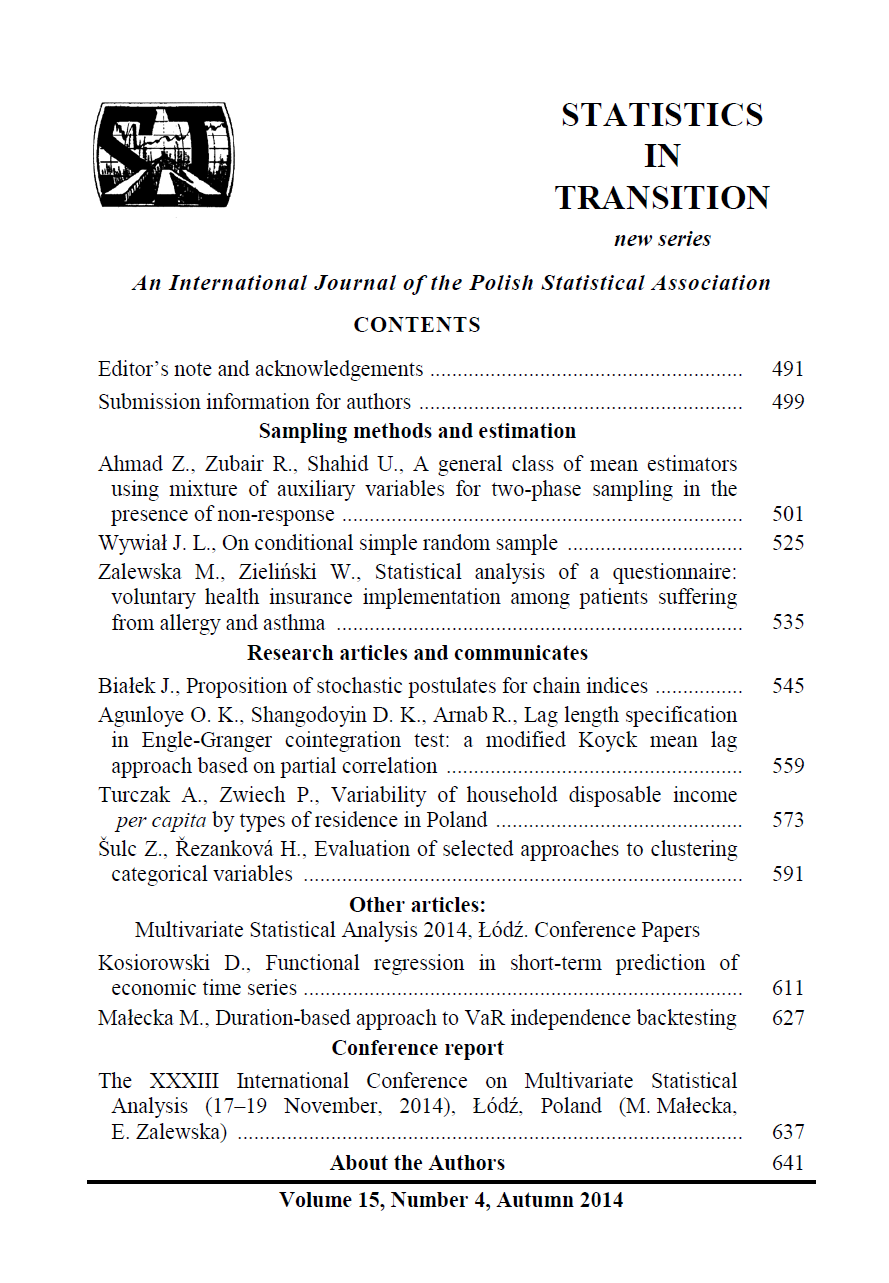ARTICLE
ABSTRACT
We compare four methods of forecasting functional time series including fully functional regression, functional autoregression FAR(1) model, Hyndman & Shang principal component scores forecasting using one-dimensional time series method, and moving functional median. Our comparison methods involve simulation studies as well as analysis of empirical dataset concerning the Internet users behaviours for two Internet services in 2013. Our studies reveal that Hyndman & Shao predicting method outperforms other methods in the case of stationary functional time series without outliers, and the moving functional median induced by Frainman & Muniz depth for functional data outperforms other methods in the case of smooth departures from stationarity of the time series as well as in the case of functional time series containing outliers.
KEYWORDS
functional data analysis, functional time series, prediction
REFERENCES
BOSQ, D., (2000). Linear Processes in Function Spaces. Springer, New-York.
BESSE, P., C., CARDOT, H., STEPHENSON, D., B., (2000). Autoregressive Forecasting of Some Functional Climatic Variations, Scandinavian Journal of Statistics, Vol. 27, No. 4, 637–687.
DIDIERIKSEN, D., KOKOSZKA, P., ZHANG, Xi, (2011). Empirical properties of forecast with the functional autoregressive model, Computational Statistics, DOI 10.1007/s00180-011-0256-2.
FEBRERO-BANDE, M., OVIEDO DE LA FUENTE, M., (2012). Statistical Computing in Functional Data Analysis: The R Package fda.usc, Journal of Statistical Software, 51(4).
FERRATY, F., VIEU, P., (2006). Nonparametric Functional Data Analysis: Theory and Practice. Springer-Verlag.
FERRATY, F., (2011). (ed.) Recent Advances in Functional Data Analysis and Related Topic. Physica-Verlag.
FRAINMAN, R., MUNIZ, G., (2001). Trimmed Means for Functional Data. Test, 10, 419–440.
GÓRECKI, T., KRZYŚKO, M., (2012). Functional Principal Component Analysis, in: Pociecha J. and Decker R. (Eds), Data Analysis Methods and its Applications, C.H. Beck, Warszawa 2012, 71–87.
HORVATH, L., KOKOSZKA, P., (2012). Inference for Functional Data with Applications, Springer, New York.
HYNDMAN, R. J., KOEHLER, A. B., ORD, J. B., SNYDER, R. D., (2008). Forecasting with exponential smoothing: the state space approach, Springer Verlag, Berlin.
HYNDEMAN, H. L., SHANG, H. L., (2009). Forecasting Functional Time Series (with discussion) Journal of the Korean Statistical Society 38(3), 199–221.
KOSIOROWSKI, D., (2012). Statistical Depth Functions in Robust Economic Analysis, Publishing House of CUE in Cracow, Cracow.
KOSIOROWSKI, D., (2015). Two Procedures for Robust Monitoring of Probability Distributions of the Economic Data Stream induced by Depth Functions, Operations Research and Decisions, Vol. 25, No. 1 (in press).
KOSIOROWSKI, D., ZAWADZKI, Z., (2014). DepthProc: An R Package for Robust Exploration of Multidimensional Economic Phenomena, arXiv:1408.4542.
KOSIOROWSKI, D., MIELCZAREK, D., RYDLEWSKI, J., SNARSKA, M.,(2014a). Sparse Methods for Analysis of Sparse Multivariate Data from Big Economic Databases, Statistics in Transition – new series, Vol. 15, No. 1, 111–133.
KOSIOROWSKI, D., MIELCZAREK, D., RYDLEWSKI, J., SNARSKA, M.,(2014b). Applications of the Functional Data Analysis for Extracting Meaningful Information from Families of Yield Curves and Income Distribution Densities, in Knowledge-Economy-Society Contemporary Tools of Organisational Resources Management, ed. P. Lula, Fundation of the CUE, 309–321.
RAMSAY, J. O., HOOKER, G., GRAVES, S., (2009). Functional Data Analysis with R and Matlab, Springer-Verlag, New-York.
SHANG, H. L., (2013). ftsa: An R Package for Analyzing Functional Time Series, The R Journal, Vol. 5/1, 65–72.
ZUO, Y., SERFLING, R., (2000). General notions of statistical depth function. The Annals of Statistics, 28: 461–482
